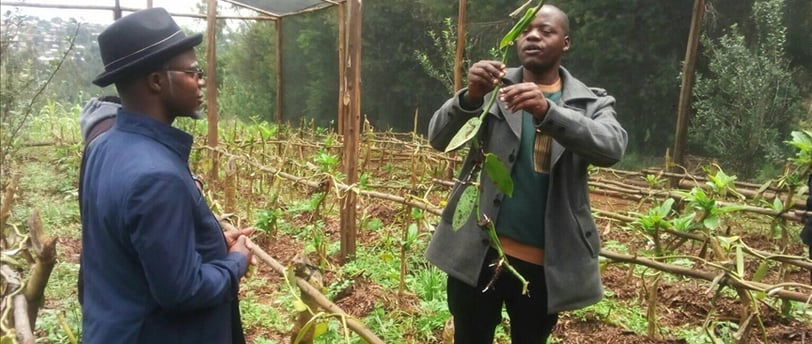How to Make Millions from Vanilla Farming in Kenya (With Real Success Stories)
Vanilla farming is an untapped goldmine in Kenya. Despite its high market value, few farmers are taking advantage of this lucrative crop. If grown and managed properly, a single vanilla plant can generate over Ksh.16,000 annually. With its widespread applications in food, beverages, cosmetics, and pharmaceuticals, vanilla presents a unique opportunity for farmers looking to maximize their earnings.
Idea Pitch
3/9/20254 min read


Vanilla farming is an untapped goldmine in Kenya. Despite its high market value, few farmers are taking advantage of this lucrative crop. If grown and managed properly, a single vanilla plant can generate over Ksh.16,000 annually. With its widespread applications in food, beverages, cosmetics, and pharmaceuticals, vanilla presents a unique opportunity for farmers looking to maximize their earnings.
How Much Can You Earn from Vanilla Farming?
Each vanilla plant can produce up to 80 beans. A single vanilla bean (10-12 cm long) sells for about Ksh.200. With an acre accommodating over 200 plants, you could potentially earn Ksh.3.2 million within three years after planting.
Yet, many Kenyan farmers shy away from vanilla farming due to the time it takes to mature. However, with the right approach and patience, the returns are worth the wait.
Growing Vanilla in Kenya: Is It Feasible?
Kenya has the perfect conditions for vanilla cultivation. The crop thrives in humid and warm regions, making areas such as the Coast, Lake regions, and parts of Western Kenya ideal for farming.
According to Shabbir Burbar, director of Maimun Ingredients Company, countries like Uganda, Comoros, and Madagascar have successfully embraced vanilla farming at both small and large scales. The major export markets for vanilla beans include Europe and the United States, where demand depends on quality.
Vanilla is widely used in the food industry, particularly in baking, dairy products, chocolates, and desserts. It is also a key ingredient in the production of perfumes, soaps, and medicinal products.
How to Start a Vanilla Farm
Starting a vanilla farm requires careful planning and investment. Here are the key steps to get started:
Choose the Right Location – Vanilla grows best in warm, humid environments with temperatures between 21-32°C. Coastal regions, parts of Western Kenya, and lake regions are ideal.
Acquire Quality Vanilla Vines – Look for healthy vanilla cuttings from reputable suppliers. Cuttings should be at least 60 cm long for better chances of survival.
Vanilla Suppliers in Kenya:
Noble Cause Enterprises – Nakuru
Signature Spice – Nairobi
Katco Ltd – Nairobi
Dahiraan Enterprises Ltd – Nairobi
Risola Foods – Various locations
Prepare the Land – Vanilla requires support to climb, so plant near existing trees such as mango, cashew nut, or plant artificial trellises.
Planting – Ensure proper spacing between plants, approximately 2.5 to 3 meters apart, to allow growth and easy management.
Provide Shade and Moisture – Vanilla vines are sensitive to direct sunlight and require adequate watering, especially during dry seasons.
Manual Pollination – Unlike other crops, vanilla flowers must be pollinated by hand as there are no natural pollinators in Kenya.
Fertilization and Maintenance – Organic manure and regular mulching improve soil fertility and plant health.
How Long It Takes to Grow Vanilla
Vanilla farming requires patience, as it takes time before you start seeing returns.
Vanilla vines take about 2 to 3 years to mature before they start flowering.
After flowering, it takes another 6 to 9 months for vanilla beans to be ready for harvesting.
The curing and drying process can take an additional 2 to 3 months before the beans are ready for sale.
Although the process is long, the high returns make vanilla farming a worthwhile investment.
Life Span of a Vanilla Plant
A well-maintained vanilla plant can produce for over 10 to 15 years. However, productivity declines after 7 to 10 years, so farmers should continuously plant new vines to ensure sustained production. Proper care, regular pruning, and maintaining healthy soil conditions can help extend the plant's lifespan and ensure consistent yields.
Why Has Vanilla Farming Struggled in Kenya?
Several companies in Kenya, including Noble Cause Enterprises in Nakuru and Signature Spice in Nairobi, previously dealt in vanilla but were forced to close or shift to other businesses due to low supply from farmers.
Vincent Labatt, the owner of Noble Cause Enterprises, switched to honey production after struggling to secure a consistent supply of vanilla. He even resorted to importing from Uganda before eventually discontinuing vanilla sales due to the high costs.
To address this issue, the Kenya Agricultural and Livestock Research Organisation (KALRO) launched a program in 2015 to boost vanilla seedling production using tissue culture technology. The initiative aimed to attract more farmers to the trade.
Success Story: A Farmer Earning Ksh.25,000 Per Kilo
Andrew Simiyu, a farmer in Mwapala, Kwale County, is proving that vanilla farming is profitable. He started his vanilla farm, Kusini Farm, in 2018 after researching the most lucrative crops to grow in tropical climates.
Initially, he invested Ksh.250,000 since he had to import vanilla vines. Today, however, vines are locally available, making it more affordable to start.
Simiyu began with one acre, later expanding to two acres, and now plans to cultivate ten acres. He grows the vanilla planifolia variety, which takes about two years to mature and another six months to bear fruit after flowering. His farm currently has 3,000 vines.
He also sells vanilla cuttings to other farmers:
60-80cm cuttings – Ksh.150
1m cuttings – Ksh.300
1.5m cuttings – Ksh.500
"The longer the cutting, the faster it matures," he explains.
One of his biggest challenges has been water scarcity, as Kwale County experiences extreme dry spells. Additionally, vanilla farming is labor-intensive since pollination is done manually.
Despite these challenges, Simiyu earns Ksh.25,000 per kilo of processed vanilla. His primary market is local buyers, including hotels and resorts in Diani Beach.
"Vanilla farming is rewarding. I encourage anyone with land and passion for farming to try it. With good management, the plant can produce for over ten years," he says. He also plans to set up a vanilla training facility to educate more farmers.
Why Now is the Best Time to Start Vanilla Farming
Vanilla is the second most expensive spice in the world, after saffron. With the right conditions and proper care, it can be a game-changer for farmers.
The demand for vanilla is high, both locally and internationally. Yet, Kenya remains an underutilized producer. By investing in vanilla farming now, you position yourself in a profitable niche with less competition.
Are you ready to tap into this opportunity? Start small, learn the process, and scale up over time. The potential earnings make the effort worthwhile.
